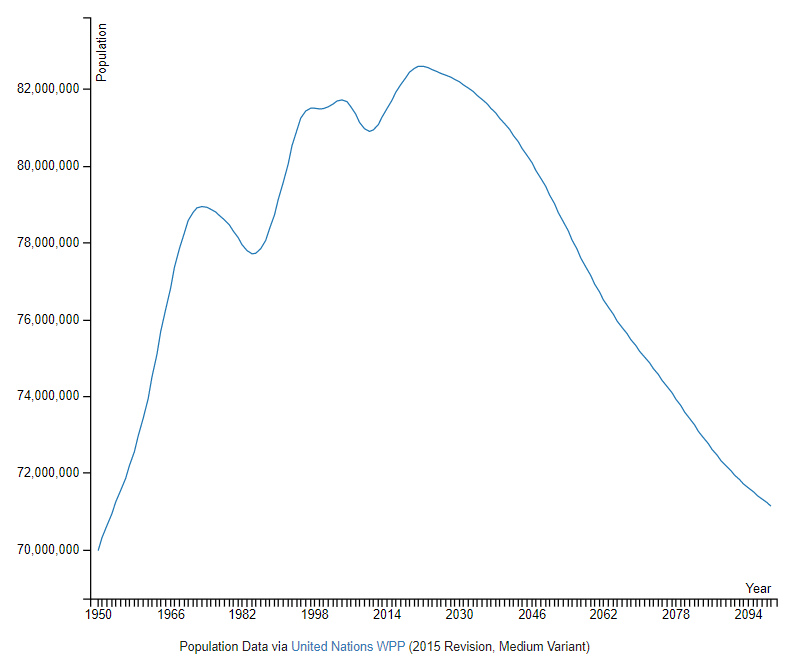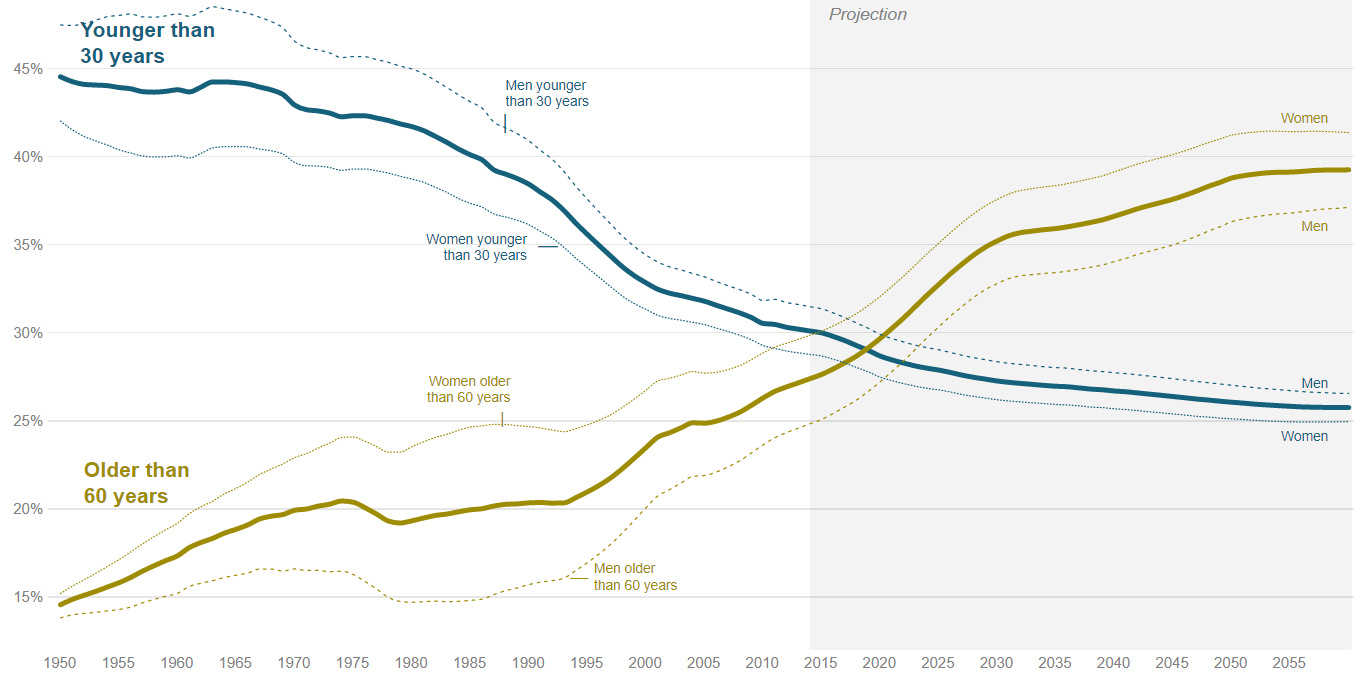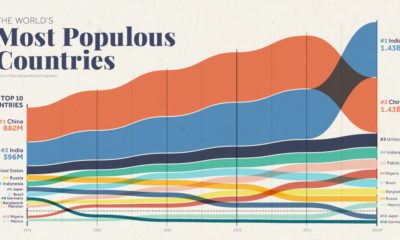According to the European Central Bank, the most recent forecast for the eurozone pegs growth at 2.3% for the year ahead, a significant upgrade from the central bank’s previous estimate of 1.8%. But as Europe regains its economic mojo, a key part of the machine is seeing demographic reality take shape.
A Scary Milestone
It’s been no secret that Germany, which has a reputation as the economic engine of Europe, is in a troubling demographic predicament. With one of the oldest populations in Europe, and a low fertility rate of just 1.5 births per woman, it is only a matter of time before the rubber hits the road to affect growth in the country. That time may be finally creeping in, and the country is poised to hit a dubious milestone in the next year that really crystallizes concerns around the demographic composition of Germany’s population. By 2019, there will be fewer Germans under 30 years old than there are Germans that are 60+ years:
This ratio is certainly extreme on a global level – after all, 24.4% of the world population is under the age of 14, and only 12.3% is older than 60 years. However, it’s also pretty extreme in comparison to other developed countries. The U.N., for example, recently estimated that the 60 and older population made up an average of 22.1% of the total for all high-income countries. Conversely, the last time the 60+ group made up the same proportion in the German economy was in 1997.
A Closer Look at Germany
For a closer look at this trend, here’s an animated and interactive chart of Germany’s population pyramid. Notice that by 2020, the shape starts to represent the negative population growth pattern that we showcased in a previous post.
Use the “lock” button to save an imprint of particular year, and then use the play button to animate future years.
Visualizing Negative Growth
With more people in the 60+ age bracket than in the younger generation, it’s inevitably a prelude to population decline in the native population. Here is this negative growth projection shown, using a more conventional graph:
Based on these United Nations projections, the German population is likely to decline by over 10 million people as we move towards the end of the 21st century. This is a stark contrast to other parts of the world, such as the booming megacities in Asia and Africa, that will soon dominate the world’s future demographic landscape.
on The good news is that the Federal Reserve, U.S. Treasury, and Federal Deposit Insurance Corporation are taking action to restore confidence and take the appropriate measures to help provide stability in the market. With this in mind, the above infographic from New York Life Investments looks at the factors that impact bonds, how different types of bonds have historically performed across market environments, and the current bond market volatility in a broader context.
Bond Market Returns
Bonds had a historic year in 2022, posting one of the worst returns ever recorded. As interest rates rose at the fastest pace in 40 years, it pushed bond prices lower due to their inverse relationship. In a rare year, bonds dropped 13%.
Source: FactSet, 01/02/2023.
Bond prices are only one part of a bond’s total return—the other looks at the income a bond provides. As interest rates have increased in the last year, it has driven higher bond yields in 2023.
Source: YCharts, 3/20/2023.
With this recent performance in mind, let’s look at some other key factors that impact the bond market.
Factors Impacting Bond Markets
Interest rates play a central role in bond market dynamics. This is because they affect a bond’s price. When rates are rising, existing bonds with lower rates are less valuable and prices decline. When rates are dropping, existing bonds with higher rates are more valuable and their prices rise. In March, the Federal Reserve raised rates 25 basis points to fall within the 4.75%-5.00% range, a level not seen since September 2007. Here are projections for where the federal funds rate is headed in 2023:
Federal Reserve Projection*: 5.1% Economist Projections**: 5.3%
*Based on median estimates in the March summary of quarterly economic projections.**Projections based on March 10-15 Bloomberg economist survey. Together, interest rates and the macroenvironment can have a positive or negative effect on bonds.
Positive
Here are three variables that may affect bond prices in a positive direction:
Lower Inflation: Reduces likelihood of interest rate hikes. Lower Interest Rates: When rates are falling, bond prices are typically higher. Recession: Can prompt a cut in interest rates, boosting bond prices.
Negative
On the other hand, here are variables that may negatively impact bond prices:
Higher Inflation: Can increase the likelihood of the Federal Reserve to raise interest rates. Rising Interest Rates: Interest rate hikes lead bond prices to fall. Weaker Fundamentals: When a bond’s credit risk gets worse, its price can drop. Credit risk indicates the chance of a default, the risk of a bond issuer not making interest payments within a given time period.
Bonds have been impacted by these negative factors since inflation started rising in March 2021.
Fixed Income Opportunities
Below, we show the types of bonds that have had the best performance during rising rates and recessions.
Source: Derek Horstmeyer, George Mason University 12/3/2022. As we can see, U.S. ultrashort bonds performed the best during rising rates. Mortgage bonds outperformed during recessions, averaging 11.4% returns, but with higher volatility. U.S. long-term bonds had 7.7% average returns, the best across all market conditions. In fact, they were also a close second during recessions. When rates are rising, ultrashort bonds allow investors to capture higher rates when they mature, often with lower historical volatility.
A Closer Look at Bond Market Volatility
While bond market volatility has jumped this year, current dislocations may provide investment opportunities. Bond dislocations allow investors to buy at lower prices, factoring in that the fundamental quality of the bond remains strong. With this in mind, here are two areas of the bond market that may provide opportunities for investors:
Investment-Grade Corporate Bonds: Higher credit quality makes them potentially less vulnerable to increasing interest rates. Intermediate Bonds (2-10 Years): Allow investors to lock in higher rates.
Both types of bonds focus on quality and capturing higher yields when faced with challenging market conditions.
Finding the Upside
Much of the volatility seen in the banking sector was due to banks buying bonds during the pandemic—or even earlier—at a time when interest rates were historically low. Since then, rates have climbed considerably. Should rates moderate or stop increasing, this may present better market conditions for bonds. In this way, today’s steep discount in bond markets may present an attractive opportunity for price appreciation. At the same time, investors can potentially lock in strong yields as inflation may subside in the coming years ahead. Learn more about bond investing strategies with New York Life Investments.





























